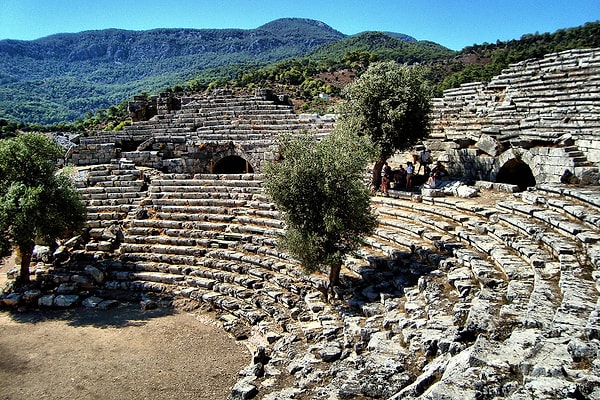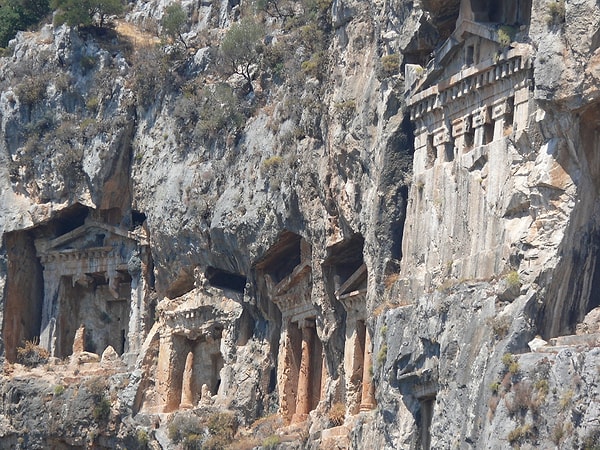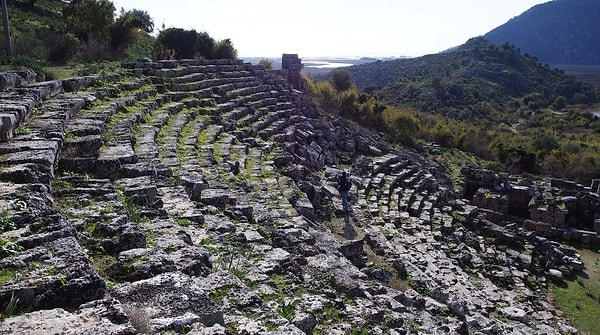Discover Kaunos Ancient City: A Complete Travel Guide to Ancient Lycian City
Located on the opposite shore of Dalyan, a town in the Ortaca district of Muğla, Kaunos Ancient City rises east of the canal connecting Köyceğiz Lake and the Mediterranean Sea. It captivates visitors not only with its ruins but also with its unique atmosphere intertwined with nature. This city, which bears the traces of antiquity, offers a multifaceted travel experience ranging from mythology to history, archaeology to nature walks. In this guide, you will find comprehensive content filled with both practical and historical information for those who want to explore Kaunos.
History of Kaunos: A Civilisation Between Caria and Lycia

Geographically located between the regions of Caria and Lycia, Kaunos was a city influenced by both cultures. According to ancient sources, the city takes its name from Kaunos, who is said to have founded it. Kaunos is the son of Miletos, who is said to be the grandson of Apollo in mythology, and was exiled to this region because of his tragic love story with his twin sister Byblis. This legend adds a romantic and mythological dimension to the city's founding legend.
The city's history dates back to the 10th century BC and has witnessed Persian, Hellenic, Roman and Byzantine rule over time. Kaunos was an important trade centre, especially due to its port. However, over time, it lost its port characteristics and importance due to the accumulation of alluvium in the delta.
Places to See in the Ancient City

The ancient city of Kaunos covers a large area. The structures date back to different periods and offer archaeological diversity. The following structures are a must-see during your visit:
Theatre: The Hellenistic theatre, built on a hillside, has a capacity of approximately 5,000 people. It is largely intact today and is impressive both for its view and its acoustics.
Acropolis: The acropolis, the highest point of the city, offers a magnificent view of the sea and the Dalyan delta. The remains of the walls built for defence purposes are still visible.
Roman Baths: These structures bear traces of the social life of the ancient city. The hot, warm and cold sections can be clearly distinguished.
Agora and Temples: Traces of trade and social life can be seen in the agora, considered the centre of the city. There are also ruins of a temple believed to be dedicated to the goddess Demeter.
Stoa and Churches: The ruins of churches from the early Byzantine period bear traces of the city's Christian life.
Rock Tombs: The Symbol of Kaunos
When Kaunos is mentioned, one of the first structures that comes to mind is undoubtedly the Lycian-style royal tombs. These monumental tombs, carved into the rock, are both architecturally impressive and offer a mystical atmosphere. As you pass by the Dalyan Canal by boat, these tombs appear in all their glory. Some of these tombs, which remain unfinished, are believed to belong to the wealthy class or rulers of the period.
Kaunos Inscriptions and Language: Silent Witnesses of Antiquity

The inscriptions found in Kaunos include not only Greek but also examples of the Carian language. The Carian language has not yet been fully deciphered, pointing to the cultural diversity of the region. These inscriptions, which provide clues about the daily life, public order and even religious practices of the local people, are of great importance to archaeologists. In particular, the texts found in the agora and around the sacred area shed light on the socio-political structure of the city.
Archaeological Excavations and Scientific Research

Archaeological excavations in Kaunos began in 1966 and have been carried out largely by Turkish archaeologists to this day. Many elements uncovered in the excavations, such as olive oil workshops, mosaic structures, cisterns and aqueducts, reveal not only the city's public life but also its daily economy. In addition, studies on ancient water systems prove that Kaunos was a city with advanced infrastructure. These excavations continue to bring new information to light every year and increase the archaeological importance of the region.
Astronomy and Symbolism: Observations on the Orientation of Buildings

The positioning of some structures in Kaunos was planned in such a way as to suggest that celestial events were tracked in ancient times. The theatre was placed so that it would not cast a shadow when the sun was at its highest point, and some temples were aligned according to specific sunrises, indicating that these orientations were conscious choices. This situation reveals that the Kaunosians associated their religious ceremonies or social events with seasonal cycles. These orientations also point to symbolic connections established between the structures and nature.
Kaunos' Trade Network and Economic Dynamics

Kaunos was especially famous for its salt production in ancient times. The salt ponds in the delta were of great commercial value and the salt from Kaunos was sent to all four corners of the Mediterranean via the harbour. In addition, olive oil workshops, fish processing areas and trade structures close to the harbour prove that Kaunos had a very vibrant economic structure. In addition, the geographical location of the city placed it at a strategic point in terms of trade routes between the east and the west.
Religious Life and Rituals: A City in the Shadow of the Gods

The religious buildings in Kaunos shed light on the polytheistic belief system of the city. There are temples dedicated to many gods, especially Apollo, Zeus and Demeter. Especially the sanctuaries located above the agora show how effective religion was in both daily life and state organisation. It is also known that the religious festivals organised around the theatre allowed both the socialisation of the people and the ritual presentation of devotion to the gods.
Transport Information: How to get to Kaunos?

Getting to the ancient city of Kaunos is a bit adventurous but quite enjoyable. Since the city is located on the opposite shore of Dalyan town, it is necessary to cross the canal by private boats or small boats. It is possible to reach Dalyan by minibus from the Ortaca district of Muğla. Ortaca can be easily accessed via Dalaman Airport. Kaunos is about 20-25 minutes on foot from Dalyan.
Other Places to See
For those who visit Kaunos, there are a few more special spots that must be seen around it:
Dalyan: It is known for both its nature and thermal mud baths. Iztuzu Beach, the habitat of Caretta caretta turtles, is also located within the borders of Dalyan.
Sultaniye Hot Springs: These hot springs, which are very close to Kaunos, are one of the important stops of thermal tourism. It is famous for its healing mud baths and natural hot water pools.
Koycegiz Lake: Koycegiz, a freshwater lake, is very convenient for water sports and nature observation. It is a good alternative to relax after a trip to Kaunos.
Keşfet ile ziyaret ettiğin tüm kategorileri tek akışta gör!

Send Comment